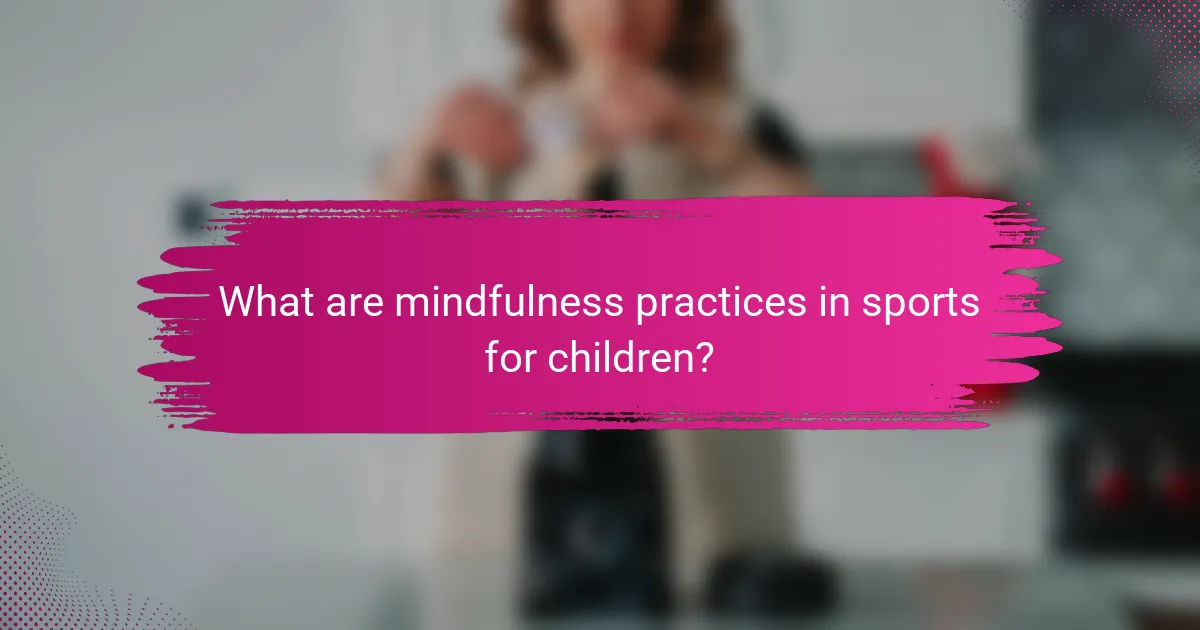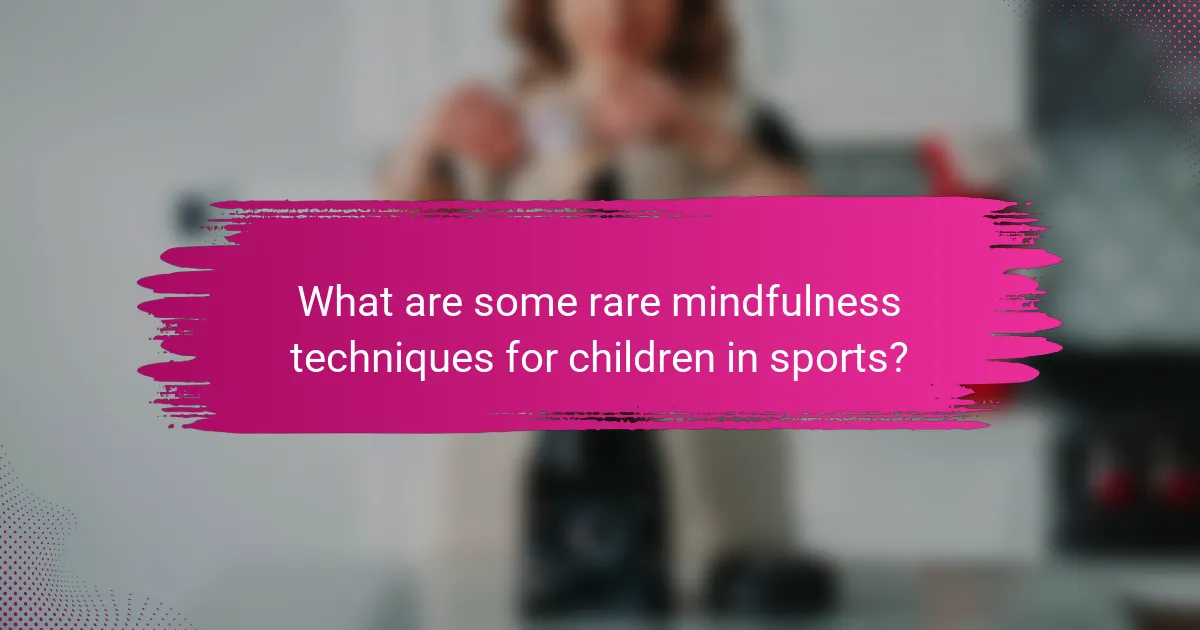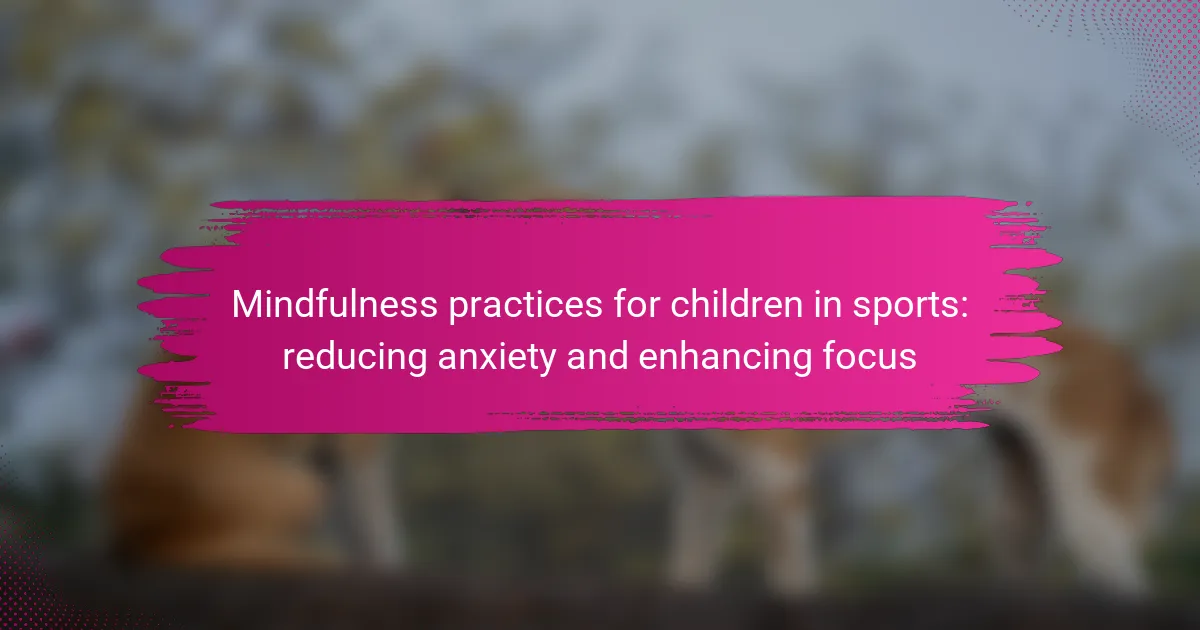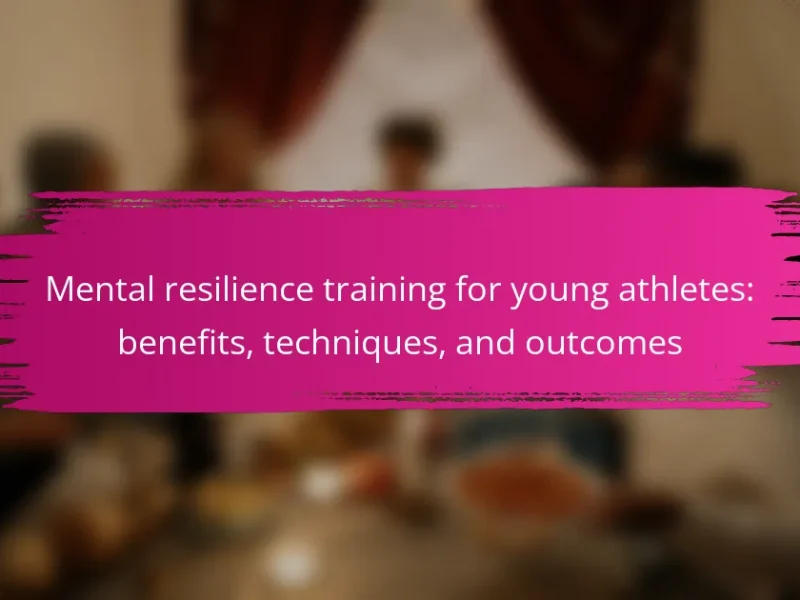Mindfulness practices for children in sports can significantly reduce anxiety and enhance focus. Techniques such as breathing exercises, visualization, and body awareness help young athletes manage stress and improve performance. Regular mindfulness training fosters resilience and emotional regulation, leading to greater enjoyment in sports activities. Cultural perceptions also influence the integration of these practices, affecting children’s overall sports experiences.

What are mindfulness practices in sports for children?
Mindfulness practices in sports for children focus on techniques that reduce anxiety and enhance concentration. These practices include breathing exercises, visualization, and body awareness. Breathing exercises help children manage stress during competitions. Visualization allows them to mentally rehearse skills, boosting confidence. Body awareness fosters a connection between mind and body, improving overall performance. Implementing these techniques can lead to greater enjoyment and resilience in sports activities.
How do these practices help reduce anxiety?
Mindfulness practices help reduce anxiety in children by promoting relaxation and enhancing focus. Techniques like deep breathing and visualization create a sense of calm, enabling young athletes to manage stress during competition. Regular practice fosters emotional regulation, allowing children to respond to challenges with resilience. Additionally, mindfulness encourages present-moment awareness, reducing negative thoughts that contribute to anxiety.
What techniques enhance focus during sports?
Mindfulness practices enhance focus during sports by teaching children to manage anxiety and stay present. Techniques such as deep breathing, visualization, and body scanning promote mental clarity. Regular practice can lead to improved performance and emotional regulation, fostering a positive sports experience.

What are the universal benefits of mindfulness for young athletes?
Mindfulness practices significantly benefit young athletes by reducing anxiety and enhancing focus. These practices improve emotional regulation, leading to better performance under pressure. Research shows that incorporating mindfulness can increase attention span and concentration, essential for competitive sports. Additionally, young athletes experience improved resilience, which helps them cope with setbacks and maintain motivation. Regular mindfulness training fosters a positive mindset, promoting overall well-being and enjoyment in sports activities.
How does mindfulness improve emotional regulation?
Mindfulness significantly enhances emotional regulation by promoting self-awareness and reducing anxiety. Practicing mindfulness helps children in sports to focus on the present moment, which decreases distractions and fosters a calm mindset. This improved focus leads to better performance and emotional stability during competitions. Research indicates that mindfulness techniques can lower stress levels, enabling children to manage their emotions more effectively. Engaging in mindfulness exercises regularly cultivates resilience, allowing young athletes to bounce back from setbacks.
What role does mindfulness play in team dynamics?
Mindfulness enhances team dynamics by fostering communication, collaboration, and emotional intelligence. It reduces anxiety and improves focus among team members, leading to better performance. Regular mindfulness practices can cultivate a supportive environment, encouraging open dialogue and trust. This approach ultimately strengthens relationships and boosts overall team effectiveness.

What unique mindfulness practices can be applied in sports?
Mindfulness practices for children in sports can significantly reduce anxiety and enhance focus. Techniques such as breath awareness help athletes center their thoughts, while visualization encourages positive imagery of performance outcomes. Body scans promote relaxation, enabling athletes to release tension. Regular practice of these methods fosters resilience, improving overall mental well-being.
How can visualization techniques be used effectively?
Visualization techniques enhance mindfulness practices for children in sports by fostering focus and reducing anxiety. Techniques like guided imagery help athletes visualize success, improving performance and confidence. Incorporating visualization into routines builds mental resilience, enabling children to manage stress effectively. Regular practice can lead to significant improvements in concentration and overall well-being.
What is the impact of breath control on performance?
Breath control significantly enhances performance by reducing anxiety and improving focus. Mindfulness practices, such as controlled breathing, help children manage stress during sports. This leads to better concentration and a more relaxed state, which can improve overall performance. Techniques like deep breathing activate the parasympathetic nervous system, promoting calmness and clarity. Engaging in these practices regularly can foster resilience and mental strength in young athletes.

What are some rare mindfulness techniques for children in sports?
Some rare mindfulness techniques for children in sports include visualization exercises, nature immersion, and mindful movement practices. These techniques help reduce anxiety and enhance focus by promoting mental clarity and emotional regulation.
Visualization exercises involve imagining successful performances, which can boost confidence. Nature immersion encourages children to connect with their surroundings, fostering calmness. Mindful movement practices, such as yoga or tai chi, integrate physical activity with mindfulness, improving concentration and relaxation during sports.
How can nature immersion enhance mindfulness in young athletes?
Nature immersion significantly enhances mindfulness in young athletes by fostering focus and reducing anxiety. Engaging with natural environments can lower stress levels, improve mood, and increase attention span. Studies show that spending time in nature can lead to a 20% increase in attention restoration. Additionally, activities like outdoor training promote a sense of connection and presence, crucial for mindfulness practices. This unique benefit of nature immersion supports overall well-being, allowing young athletes to perform better in their sports.
What role does creative expression play in mindfulness?
Creative expression enhances mindfulness in children by promoting self-awareness and emotional regulation. Engaging in activities like art or music allows young athletes to focus on the present moment, reducing anxiety and improving concentration. This practice fosters a unique attribute of creativity, which can lead to better performance in sports. Additionally, creative expression serves as a tool for stress relief, helping children manage competitive pressures effectively.

How do cultural perceptions influence mindfulness practices in sports?
Cultural perceptions significantly shape mindfulness practices in children’s sports by influencing their acceptance and integration. For instance, cultures that prioritize mental well-being may encourage mindfulness techniques, enhancing focus and reducing anxiety. In contrast, cultures emphasizing competition may view such practices as less important. As a result, children’s engagement with mindfulness varies widely based on cultural context, impacting their overall sports experience and performance.
What adaptations are necessary for different age groups?
Different age groups require tailored mindfulness practices in sports to effectively reduce anxiety and enhance focus. Children benefit from playful, engaging techniques like guided imagery and breathing exercises, while adolescents may respond better to structured mindfulness sessions that incorporate goal-setting.
For children aged 5-10, practices should be short and interactive, focusing on fun activities that capture their attention. For ages 11-14, incorporating discussions about emotions and stress management can deepen their understanding and application. Older teens, from 15-18, may find value in self-reflection techniques that promote independence and personal growth.
Adapting mindfulness practices to these age-specific needs ensures they are developmentally appropriate and effective in fostering a positive sporting experience.
How can coaches integrate mindfulness into training routines?
Coaches can integrate mindfulness into training routines by incorporating focused breathing exercises and guided visualizations. These practices help children reduce anxiety and enhance focus during sports activities.
1. Start sessions with a brief breathing exercise to center attention.
2. Use visualization techniques to help athletes imagine successful performance.
3. Encourage regular check-ins on mental state during practice.
4. Implement mindfulness games that promote awareness and concentration.
These strategies foster a supportive environment, enhancing children’s overall sports experience.

What are best practices for implementing mindfulness in youth sports?
To implement mindfulness in youth sports, coaches should focus on techniques that reduce anxiety and enhance focus. Incorporating breathing exercises can help athletes center their thoughts. Setting aside time for mindfulness sessions before practices or games promotes mental clarity. Encouraging self-reflection post-activity aids in recognizing emotional responses and improving performance. Creating a supportive environment fosters open discussions about feelings, enhancing emotional intelligence. Regularly integrating these practices can lead to improved concentration and reduced stress levels in young athletes.
What common mistakes should be avoided when teaching mindfulness?
To teach mindfulness effectively to children in sports, avoid common mistakes such as overcomplicating practices, neglecting age-appropriate techniques, and failing to create a supportive environment. Simplifying mindfulness exercises helps children grasp concepts easily. Tailoring practices to their developmental stage enhances engagement. Additionally, fostering a positive atmosphere encourages participation and openness.
How can parents support mindfulness practices at home?
Parents can support mindfulness practices at home by creating a calm environment and incorporating mindfulness activities into daily routines. Establishing a designated quiet space for meditation or breathing exercises can enhance focus and reduce anxiety in children. Encouraging regular practices, such as mindful eating or nature walks, helps children develop awareness and presence. Additionally, modeling mindfulness through their own practices reinforces its importance and effectiveness.
What expert insights can enhance the effectiveness of mindfulness in sports?
Mindfulness practices can significantly enhance children’s performance in sports by reducing anxiety and improving focus. Expert insights suggest incorporating regular mindfulness exercises, such as breathing techniques and visualization, tailored to children’s developmental stages.
Research indicates that consistent mindfulness practice can lead to a 30% reduction in anxiety levels among young athletes. Additionally, engaging in mindfulness activities before competitions can enhance concentration, allowing children to perform at their best.
Unique attributes of mindfulness in sports include its adaptability to various age groups and sports disciplines. Coaches can implement short mindfulness sessions during training, fostering a supportive environment that nurtures mental resilience.
As a result, integrating mindfulness into sports routines not only supports emotional well-being but also cultivates a positive mindset, essential for long-term athletic success.


